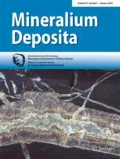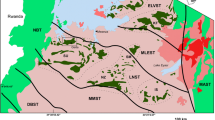Abstract
Two types of structurally controlled hydrothermal mineralization have occurred during folding of fissile schist in southern New Zealand: fold-related mineralization and normal fault-related mineralization. Both types have the same mineralogy and textures, and are dominated by quartz–ankerite veins and silicified breccias with ankeritic alteration. Most mineralized zones are thin (centimetre scale), although host schist is commonly impregnated with ankerite up to 20 m away. Thick (up to 5 m wide) mineralized zones are generally gold-bearing and contain pyrite and arsenopyrite with stibnite pods locally. Some of these auriferous zones have been extensively mined historically despite rugged topography and difficult access. Mineralization occurred during regional tectonic compression in the initial stages of development of the Southern Alps mountain belt at the Pacific–Australian plate boundary in the Miocene. Most of the gold-bearing deposits occur in east to south-east, striking normal faults that cut across mesoscopic folds in a belt that coincides with the southern termination of a regional-scale north trending antiform. Mineralized zones have similar structural control and relative timing to a nearby swarm of Miocene lamprophyre dykes and carbonatites. Limited stable isotopic data (C and O) and trace element geochemistry suggest that there was probably no genetic link between the igneous activity and gold mineralization. However, these two types of fluid flow have been controlled by the same tectonically created crustal plumbing system. This Miocene hydrothermal activity and gold deposition demonstrates that orogenic (mesothermal) mineralization can occur during the inception of an orogenic belt, not just in the latter stages as is commonly believed. These Miocene structures have been preserved in the orogen because the locus of uplift has moved northwards, so the early-formed gold deposits have not yet been structurally overprinted or eroded.













Similar content being viewed by others
References
Ashley PM, Cook NDJ, Hill RL, Kent AJR (1994) Shoshonitic lamprophyre dykes and their relation to mesothermal Au-Sb veins at Hillgrove, New South Wales, Australia. Lithos 32:249–272
Begbie M, Craw D (2006) Gold mineralisation in the Shotover–Macetown region, NW Otago, New Zealand. In: Christie AB, Brathwaite R (eds) Geology and exploration of New Zealand mineral deposits. AIMM Monogr 25:299–304
Bierlein FP, Crowe D (2000) Phanerozoic orogenic lode gold deposits. In: Hagemann SG, Brown PE (eds) Gold in 2000. Rev Econ Geol 13:103–140
Blattner P, Cooper AF (1974) Carbon and oxygen isotopic composition of carbonatitic dikes and metamorphic country rock of the Haast Schist terrain, New Zealand. Contrib Mineral Petrol 44:17–27
Carter RM, Norris RJ (1976) Cainozoic history of southern New Zealand: an accord between geological observations and plate tectonic predictions. Earth Planet Sci Lett 31:85–94
Cassidy KF, Hagemann SG (1999) Archean high P-T, granitoid-hosted gold mineralization at Westonia, Western Australia: I. Evidence for syn-peak metamorphic mineralization in a high grade terrain. In: Stanley CJ (ed) Mineral deposits, processes to processing. Balkema, Rotterdam, pp 1013–1016
Cooper AF (1986) A carbonatitic lamprophyre dike swarm from the Southern Alps, Otago and Westland. Cenozoic volcanism in New Zealand. R Soc N Z Bull 23:313–336
Cooper AF, Barreiro BA, Kimbrough DL, Mattinson JM (1987) Lamprophyre dike intrusion and the age of the Alpine fault, New Zealand. Geology 15:941–944
Cox SF, Wall VJ, Etheridge MA, Potter TF (1991) Deformation and metamorphic processes in the formation of mesothermal vein-hosted gold deposits: examples from the Lachlan Fold Belt in central Victoria, Australia. Ore Geol Rev 6:391–423
Craw D (1985) Structure of the schists in the Mt Aspiring region, northwestern Otago. N Z J Geol Geophys 28:55–75
Craw D (1989) Shallow-level, late-stage gold mineralisation in Sawyers Creek, Shotover valley, North West Otago, New Zealand. N Z J Geol Geophys 32:375–384
Craw D (1995) Reinterpretation of the erosion profile across the southern portion of the Southern Alps, Mt Aspiring area, Otago, New Zealand. N Z J Geol Geophys 38:501–507
Craw D (2002) Geochemistry of late metamorphic hydrothermal alteration and graphitisation of host rock, Macraes gold mine, Otago Schist, New Zealand. Chem Geol 191:257–275
Craw D (2006) Gold-bearing veins in the Southern Alps, New Zealand In: Christie AB, Brathwaite R (eds) Geology and exploration of New Zealand mineral deposits. AIMM Monogr 26:285–288
Craw D, Campbell JR (2004) Tectonic and structural setting for active mesothermal gold vein systems, Southern Alps, New Zealand. J Struct Geol 26:995–1005
Craw D, Norris RJ (1991) Metamorphogenic Au–W veins and regional tectonics: mineralisation throughout the uplift history of the Haast Schist, New Zealand. N Z J Geol Geophys 34:373–383
Craw D, Reay A, Johnstone RD (1991) Hydrothermal alteration geochemistry of Nugget gold vein system, Shotover valley, northwest Otago, New Zealand. N Z J Geol Geophys 34:419–427
Craw D, Koons PO, Horton T, Chamberlain CP (2002) Tectonically driven fluid flow and gold mineralisation in active collisional orogenic belts: comparison between New Zealand and western Himalaya. In: Labaume P, Craw D, Lespinasse M, Muchez P (eds) Tectonic processes and flow of mineralizing fluids. Tectonophysics 348:135–153
DeMets C, Gordon RG, Argus DF, Stein S (1994) Effect of recent revisions to the geomagnetic reversal time scale on estimates of current plate motions. Geophys Res Lett 21:2191–2194
Forde A (1991) The late orogenic timing of mineralization in some slate belt gold deposits, Victoria, Australia. Miner Depos 26:257–266
Goldfarb RJ, Groves DI, Gardoll S (2001) Orogenic gold and geologic time: a global synthesis. Ore Geol Rev 18:1–75
Goldfarb RJ, Baker T, Dube B, Groves DI, Hart CJ, Gosselin P (2005) Distribution, character and genesis of gold deposits in metamorphic terranes. In: Hedenquist JW, Thompson JFH, Goldfarb RJ, Richards JP (eds) Economic Geology 100th Anniversary Volume. Society of Economic Geologists, Littleton, pp 407–450
Gray DR, Foster DA (2004) 40Ar/39Ar thermochronologic constraints on deformation, metamorphism and cooling/exhumation of a Mesozoic accretionary wedge, Otago Schist, New Zealand. Tectonophysics 385:181–210
Groves DI, Goldfarb RJ, Robert F, Hart CJR (2003) Gold deposits in metamorphic belts: overview of current understanding, outstanding problems, future research, and exploration significance. Econ Geol 98:1–29
Jackson J, Norris RJ, Youngson JH (1996) The structural evolution of active fault and fold systems in Central Otago, New Zealand: evidence revealed by drainage patterns. J Struct Geol 18:217–234
Kerrich R, Wyman DA (1994) The mesothermal gold lamprophyre association: significance for an accretionary geodynamic setting, supercontinent cycles, and metallogenic processes. Min Pet 51:147–172
McClay K (1987) The mapping of geological structures. Geological Society of London Handbook. Wiley, New York, p 161
Nesbitt BE, Murowchick JB, Muehlenbachs K (1986) Dual origins of lode gold deposits in the Canadian Cordillera. Geology 14:506–509
Norris RJ, Craw D (1987) Aspiring Terrane: an oceanic assemblage from New Zealand and its implications for terrane accretion in the southwest Pacific. Geodynamics 19:169–177
Norris RJ, Koons PO, Cooper AF (1990) The obliquely convergent plate boundary in the South Island of New Zealand: implications for ancient collision zones. J Struct Geol 12:715–726
Paterson L (1992) A study of carbonatites and associated fenirisation at Haast River, southwestern New Zealand. Unpublished Ph.D. thesis, University of Otago Library, Dunedin
Rock NMS, Groves DI, Perring CS, Golding SD (1989) Gold, lamprophyres, and porphyries: what does their association mean? In: Keays RR, Ramsay RH, Groves DI (eds) The geology of gold deposits. Econ Geol Monogr 6:609–625
Sibson RH, Scott J (1998) Stress/fault controls on the containment and release of overpressured fluids: examples from gold–quartz vein systems in Juneau, Alaska; Victoria, Australia; and Otago, New Zealand. Ore Geol Rev 13:293–306
Sibson RH, Robert F, Poulsen KH (1988) High-angle reverse faults, fluid-pressure cycling, and mesothermal gold–quartz deposits. Geology 16:551–555
Simpson GD, Cooper AF, Norris RJ (1994) Late Quaternary evolution of the Alpine Fault Zone at Paringa, South Westland, New Zealand. N Z J Geol Geophys 37:49–58
Taylor WR, Rock NMS, Groves DI, Perring CS, Golding SD (1994) Geochemistry of Archean shoshonitic lamprophyres from the Yilgarn Block, Western Australia: Au abundance and association with gold mineralization. Appl Geochem 9:197–222
Teagle DAH, Norris RJ, Craw D (1990) Structural controls on gold-bearing quartz mineralization in a duplex thrust system, Hyde-Macraes Shear Zone, Otago Schist, New Zealand. Econ Geol 85:1711–1719
Teagle DAH, Hall CM, Cox SC, Craw D (1998) Ar/Ar dating and uplift rate of hydrothermal minerals in the Southern Alps, New Zealand. In: Arehart GB, Hulston JR (eds) Proceedings, 9th International Symposium on Water–Rock Interaction. Balkema, Rotterdam, pp 801–804
Turnbull IM (2000) Geology of the Wakatipu area. Institute of Geological & Nuclear Sciences 1:250 000 geological map 18. 1 sheet + 72p. Institute of Geological & Nuclear Sciences, Lower Hutt
Turnbull IM, Barry JM, Carter RM, Norris RJ (1975) The Bobs Cove beds and their relationship to the Moonlight Fault Zone. J R Soc N Z 5:355–394
Wellman H (1979) An uplift map for the South Island of New Zealand, and a model for uplift of the Southern Alps. In: Walcott RI, Cresswell MM (eds) The origin of the Southern Alps. R S N Z Bull 18:13–20
Williams GJ (1974) Economic geology of New Zealand. AIMM Monogr 4
Witt WK, Vanderhor F (1998) Diversity within a unified model for Archean gold mineralization in the Yilgarn Craton of Western Australia: an overview of the late-orogenic structurally controlled gold deposits. Ore Geol Rev 13:29–64
Acknowledgements
This study was supported financially by the NZ Foundation for Research, Science and Technology, and the University of Otago. Permission to collect samples in a conservation area was kindly given by the Department of Conservation. Discussions with Alan Cooper, Peter Koons, Richard Norris and Rick Sibson helped us develop the ideas expressed herein. Constructive comments from James Macdonald and Anthony Harris improved the presentation.
Author information
Authors and Affiliations
Corresponding author
Additional information
Editorial handling: N. White
Rights and permissions
About this article
Cite this article
Craw, D., Begbie, M. & MacKenzie, D. Structural controls on Tertiary orogenic gold mineralization during initiation of a mountain belt, New Zealand. Miner Deposita 41, 645–659 (2006). https://doi.org/10.1007/s00126-006-0088-0
Received:
Accepted:
Published:
Issue Date:
DOI: https://doi.org/10.1007/s00126-006-0088-0




